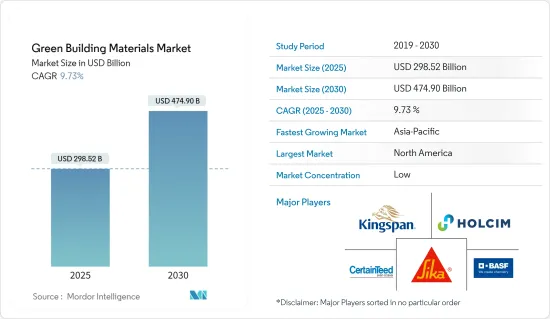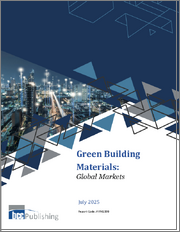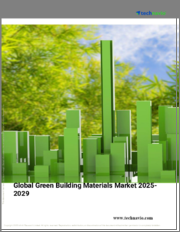
|
시장보고서
상품코드
1685820
그린 건축자재 : 시장 점유율 분석, 산업 동향 및 통계, 성장 예측(2025-2030년)Green Building Materials - Market Share Analysis, Industry Trends & Statistics, Growth Forecasts (2025 - 2030) |
||||||
그린 건축자재 시장 규모는 2025년에 2,985억 2,000만 달러에 달할 것으로 추정됩니다. 예측기간(2025-2030년)의 CAGR은 9.73%를 나타낼 것으로 전망되고, 2030년에는 4,749억 달러에 이를 것으로 예상됩니다.

2020년과 2021년 전반의 COVID-19 발생은 정부의 금지와 제한으로 인해 세계 건설 부문에 큰 영향을 미치고 그린 건축자재 시장의 성장을 제한했습니다. 주거용 부동산은 주요 도시의 엄격한 봉쇄 조치로 인해 주택 등록이 중단되고 주택 융자 실행이 지연되어 최악의 타격을 입었습니다. 그러나 이러한 규제가 해제된 이래로 이 분야는 순조롭게 회복되고 있습니다. 주택 판매 증가, 신규 프로젝트 시작, 신규 사무실 및 상업 공간 수요 증가가 지난 2년간 시장 회복을 이끌어 왔습니다.
주요 하이라이트
- 중기적으로 에너지 효율적인 건물에 그린 건축자재를 적용 할 가능성은 조사 대상 시장의 성장을 견인하는 주요 요인입니다. 또한, 녹색 건축의 건설을 지원하고 모든 건설 부서에 표준 관행을 보장하는 유리한 정부 정책이 있습니다. 이러한 정책은 건축자재 제조업체가 자사 제품에 더 많은 녹색 재료 구성/시스템을 포함하도록 촉구하고 있습니다.
- 반면, 기존 건물과 비교했을 때, 그린빌딩 건설을 위한 최초의 설비 투자가 고액인 것이 예측 기간 동안 조사된 시장의 성장을 억제할 것으로 예상되는 주요 요인이 되고 있습니다.
- 그럼에도 불구하고, 탄소 중립의 달성을 위한 다양한 경제권의 주목이 높아지고, 장기간에 걸쳐 그린 빌딩의 운영 비용의 저하, 재활용 건축 동향 증가는 곧 세계 시장에 유리한 성장 기회를 가져올 것으로 보입니다.
- 예측 기간 동안 북미가 시장을 독점할 것으로 예상됩니다. 이러한 이점은 주택, 상업, 산업, 인프라 부문에서 골조, 지붕, 단열재 및 기타 다양한 용도에 대한 수요가 높기 때문입니다.
그린 건축자재 시장 동향
주택 최종 이용 산업에서 그린 건축자재 소비 증가
- 주택 산업은 그린 건축자재의 주요 최종 사용자 산업입니다. 에너지 효율이 높고, 습기에 강하고, 내구성이 뛰어나고, 유지 보수가 용이한 재료에의 기호가 높아져, 다양한 유형의 그린 건축자재가 주택에서 인기를 끌고 있습니다. 개인의 안전성, 그린 건축자재에 대한 의식 증가와 친근감, 정부의 규제 등의 요인이 주택용도에 있어서의 그린 건축자재의 지속적인 사용 증가를 뒷받침하고 있습니다.
- 섬유 시멘트 사이딩, 열 개질 목재, 대나무, 플라이 애쉬 또는 애쉬 클리트, 도장 클리트, 재생 플라스틱은 주택 건설 산업에서 채용이 증가하는 그린 건축자재의 일부입니다. 셀룰로오스, 대마, 코르크와 같은 천연 소재는 단열재로 사용됩니다.
- 면, 황마, 울 등의 천연섬유, 테라조 등의 재활용 소재, 재활용 콘크리트, 치장 벽토, 돌, 고무계 소재 등도 주택 분야의 다양한 용도로 채용되고 있는 그린 건축자재의 하나입니다.
- 각국 정부는 그린 주택 프로젝트의 건설을 촉진하기 위해 그린 주택 우대 조치를 마련하고 있습니다. 예를 들어, 미국과 스페인의 세액 공제, 싱가포르의 그린마크 장려 프로그램, 뉴질랜드 보조금 등이 이 나라에서 그린 주택 건축의 건설을 촉진하고 있으며, 이는 이 시장의 연구에 유리하게 작용할 것으로 보입니다.
- 작년 일본은 그린 빌딩의 리더로서 크게 전진해, 에너지 환경 설계 리더십(LEED) 포트폴리오의 눈부신 확대를 계속하고 있습니다. 일본의 LEED 참여 프로젝트는 268개를 넘어 그 총 면적은 약 2,950만 평방 피트에 이릅니다.
- 또한 독일의 Kreditanstalt fur Wiederaufbau(KfW) 프로그램은 기준 성능을 초과하는 인증 평가를 충족하는 건설 및 개조 프로젝트에 저금리 대출 및 보조금을 제공합니다.
- 중국은 세계 최대의 건설 시장입니다. 중국 정부는 13차 5개년 계획을 우선하고 그린 빌딩에 대한 노력을 계획하고 있습니다. 일본의 기후 변화에 관한 국가공약에서는 2020년까지 건설된 신축건물의 50%를 녹색건축으로 인정할 것을 요구했습니다.
- 인도에는 약 6,548건의 그린 빌딩 프로젝트가 등록되어 있습니다. 2021년 6월, IIA와 CII-IGBC는 건축 설계 및 계획 분야에서 그린 빌딩 기술을 뒷받침하는 협정에 서명했습니다.
- 위와 같은 요인들로부터 주택건설용도의 그린 건축자재의 사용량과 수요는 예측기간 동안 확대될 것으로 예상됩니다.
시장을 독점하는 북미
- 북미에서는 모든 유형의 건설 활동에서 그린 건축자재의 소비 수준이 높은 것이 그린 건축자재 시장의 성장을 가속하는 주요 요인입니다.
- LEED 평가 시스템은 미국에서 가장 널리 사용되는 그린 빌딩 평가 시스템입니다. LEED는 건강하고 효율적이며 이산화탄소 배출을 줄이고 비용 절감을 실현하는 그린 빌딩 프레임 워크를 제공합니다. LEED 인증을 받은 건물은 비용을 절감하고 효율성을 높이고 이산화탄소 배출량을 줄입니다.
- USGBC에 따르면 2022년 10월 기준 미국에는 약 20,125건의 LEED 인증 프로젝트, 21,068건의 실버 프로젝트, 21,206건의 골드 프로젝트, 7,027건의 백금 프로젝트가 진행됐습니다.
- 미국에너지정보국에 따르면 2021년 주택·상업부문의 에너지 소비량은 21조Btu에 이르러 국내 최종 에너지 소비량의 28%를 차지했습니다. 미국 정부는 저소득지역의 약 45만호의 주택을 에너지 효율적인 구조로 바꾸고, 이 나라의 광열비를 줄이기 위해 31억 6,000만 달러를 투자할 계획을 발표했습니다.
- 캐나다 정부는 환경을 보호하고 기후 변화의 영향을 줄이기 위해 2030년까지 온실가스의 총 배출량을 2005년 대비 40-45% 삭감하고 2050년까지 인터넷 제로를 달성할 것을 약속하고 있습니다. 이러한 목표를 달성하기 위해, 이 나라는 2022년 캐나다 그린 빌딩 전략 개발에 1억 5,000만 캐나다 달러를 기부했습니다. 이 전략은 이 목표를 달성하기 위해 시장을 변화시키고 비용을 절감하기 위한 국가적 행동을 동원하는 것입니다.
- WGBC에 따르면 캐나다에서 그린 빌딩의 실적이 가장 높은 부문은 시설의 신축입니다. 현재 캐나다 국내 신축 프로젝트의 3분의 1 이상이 환경을 배려한 것으로, 이 수는 향후 수년에 크게 증가할 것으로 보입니다. 환경 규제와 에너지 소비 감소는 캐나다에서 그린 빌딩 산업의 성장을 가속하는 요인이되었습니다.
- USGBC에 따르면 2021년 멕시코는 LEED 인증 취득 면적(제곱피트)에서 세계 10위를 차지했으며 총 47개 프로젝트에서 10,285,729.57제곱피트의 값을 기록했습니다.
- 또한 2021년 12월 기준 피브라 맥쿼리와 피브라 숍의 두 멕시코 REIT가 리노베이션 투자와 높은 퀄리티 온 엔트리 기준의 조합으로 포트폴리오 전체의 녹색 인증 획득을 진행했습니다. 멕시코의 민간 기업도 LEED와 그린 빌딩에 대한 헌신을 표명합니다.
- 위의 모든 요인은 예측 기간 동안 북미의 그린 건축자재 시장 성장을 가속할 것으로 보입니다.
그린 건축자재 산업 개요
세계의 그린 건축자재 시장은 단편화되어 있으며 많은 기업이 작은 점유율을 차지합니다. 주요 기업(특별한 순서 없음)은 Sika AG, Kingspan Group, Holcim, Saint-Gobain(CertainTeed), BASF SE 등입니다.
기타 혜택 :
- 엑셀 형식 시장 예측(ME) 시트
- 3개월간의 애널리스트 서포트
목차
제1장 서론
- 조사의 전제조건
- 조사 범위
제2장 조사 방법
제3장 주요 요약
제4장 시장 역학
- 성장 촉진요인
- 단열재와 에너지 절약 건물에 대한 수요 증가
- 그린빌딩에 대한 정부의 호의적인 정책
- 성장 억제요인
- 기존 빌딩에 비해 높은 초기 설비 투자 비용
- 업계 밸류체인 분석
- Porter's Five Forces 분석
- 공급기업의 협상력
- 구매자의 협상력
- 신규 참가업체의 위협
- 대체품의 위협
- 경쟁 기업 간 경쟁 강도
제5장 시장 세분화
- 용도
- 골조
- 단열재
- 지붕
- 외부 사이딩
- 내부 마감
- 기타 용도
- 최종 이용 산업
- 주택
- 상업
- 산업 및 기관
- 인프라
- 지역
- 아시아태평양
- 중국
- 인도
- 일본
- 한국
- 기타 아시아태평양
- 북미
- 미국
- 캐나다
- 멕시코
- 유럽
- 독일
- 영국
- 이탈리아
- 프랑스
- 기타 유럽
- 남미
- 브라질
- 아르헨티나
- 기타 남미
- 중동 및 아프리카
- 사우디아라비아
- 남아프리카
- 기타 중동 및 아프리카
- 아시아태평양
제6장 경쟁 구도
- M&A, 합작사업, 제휴, 협정
- 시장 점유율(%)**/랭킹 분석
- 주요 기업의 전략
- 기업 프로파일
- BASF SE
- Binderholz GmbH
- Dupont
- Holcim
- Interface Inc.
- Kingspan Group
- Owens Corning
- PPG Industries Inc.
- Saint-Gobain(Certainteed)
- Sika AG
- Soben International(Asia-Pacific) Ltd
제7장 시장 기회와 앞으로의 동향
- 일부 경제국에 의한 탄소 중립 달성에 대한 주목의 고조
- 기타 기회
The Green Building Materials Market size is estimated at USD 298.52 billion in 2025, and is expected to reach USD 474.90 billion by 2030, at a CAGR of 9.73% during the forecast period (2025-2030).

The outbreak of COVID-19 in 2020 and the first half of 2021 significantly affected the global construction sector due to government-imposed bans and restrictions, thereby limiting the growth of the green building materials market. Residential real estate was the worst hit as strict lockdown measures across major cities resulted in the suspension of home registrations and slow disbursements of home loans. However, the sector has been recovering well since these restrictions were lifted. An increase in house sales, new project launches, and an increasing demand for new offices and commercial spaces have been leading the market recovery over the last two years.
Key Highlights
- Over the medium term, the potential application of green building materials in energy-efficient buildings is the major driving factor driving the growth of the market studied. Furthermore, there are favorable government policies that support green building construction and ensure standard practices across all construction sectors. These policies are prompting the manufacturers of construction materials to include more green material compositions/systems in their products.
- On the flip side, the high first capital investments for green building construction when compared to conventional buildings is the key factor anticipated to restrain the growth of the market studied over the forecast period.
- Nevertheless, the increasing focus of various economies on achieving carbon neutrality, the declining operation costs of green buildings over time, and the growing trends in recycled construction are likely to create lucrative growth opportunities for the global market soon.
- North America is expected to dominate the market during the forecast period. This dominance is attributed to the high demand for framing, roofing, insulation, and various other applications in the residential, commercial, industrial, and infrastructure sectors.
Green Building Materials Market Trends
Increasing Consumption of Green Building Materials in the Residential End-use Industry
- The residential industry is the major end-user industry for green building materials. Various types of green building materials are gaining popularity in residential buildings owing to the increasing preference for materials that are energy-efficient, moisture-resistant, durable, and easy to maintain. Factors like personal safety, increasing awareness and affinity toward green building materials, and government regulations favor the continuous increase in the use of green building materials for residential applications.
- Fiber cement siding, thermally modified wood, bamboo, fly ash or ashcrete, hempcrete, and recycled plastic are some green construction materials that are witnessing increased adoption in the residential construction industry. Other natural materials, like cellulose, hemp, and cork, are used for insulation applications.
- Natural fibers such as cotton, jute, and wool, recycled materials such as terrazzo, and recycled concrete, stucco, stone, and rubber-based materials are also among the green building materials employed in various applications in the residential sector.
- The governments of various countries are providing green housing incentives to promote the construction of green residential projects. For instance, tax credits in the United States and Spain, the Green Mark incentive program in Singapore, and subsidies in New Zealand are promoting the construction of green residential buildings in the country, which is likely to favor the market studied.
- Over the last year, Japan made significant strides in green building leadership and continues to expand its impressive Leadership in Energy and Environmental Design (LEED) portfolio. Japan has more than 268 projects participating in LEED, comprising approximately 29.5 million sq. ft.
- Also, the Kreditanstalt fur Wiederaufbau (KfW) program in Germany provides low-interest loans and grants for construction and renovation projects that meet certification ratings beyond code performance.
- China is the world's largest construction market. The Chinese government prioritized the country's 13th Five Year Plan, which has schemes for green building initiatives. The country's national climate commitment calls for 50% of all new buildings constructed by 2020 to be certified green.
- India has around 6,548 registered green building projects. In June 2021, the IIA and the CII-IGBC signed an agreement to boost green building methods in the areas of architectural design and planning.
- Owing to all the above factors, the usage and demand of green building materials for residential construction applications are expected to grow during the forecast period.
North America to Dominate the Market
- In North America, the high level of consumption of green building materials across all types of construction activities is the primary factor driving the growth of the green building materials market.
- The LEED rating system is the most widely used green building rating system in the United States. It provides a framework for healthy, efficient, carbon-saving, and cost-saving green buildings. LEED-certified buildings save money, improve efficiency, and lower carbon emissions.
- According to the USGBC, as of October 2022, the United States had around 20,125 Certified LEED projects, 21,068 Silver projects, 21,206 Gold projects, and 7,027 Platinum projects.
- According to the US Energy Information Administration, the energy consumption by the residential and commercial sectors in 2021 was rounded to 21 quadrillion Btu, which made up 28% of the country's end-use energy consumption. The high energy demand from buildings has drawn the attention of the US government, which has announced its plans to invest USD 3.16 billion to transform around 450,000 homes in low-income areas into energy-efficient structures and cut down on the country's utility bills.
- The Government of Canada has committed to reducing the country's total GHG emissions to 40-45% below 2005 levels by 2030 and to reach net zero by 2050 in order to protect the environment and reduce the impacts of climate change. To achieve such goals, the country's budget for 2022 committed CAD 150 million to develop the Canada Green Buildings Strategy. This strategy will mobilize national action to transform markets and reduce costs to meet this goal.
- According to the WGBC, the best-performing sector for green buildings in Canada is new institutional construction. Currently, over one-third of all new projects in the country are green, and this number is likely to grow significantly in the coming years. Environmental regulations and reduction in energy consumption are the factors driving the growth of the green building industry in Canada.
- According to the USGBC, in 2021, Mexico held the 10th position globally in terms of square feet (sq. ft) of LEED certification, with a value of 10,285,729.57 sq. ft in a total of 47 projects.
- Also, as of December 2021, two Mexican REITs, Fibra Macquarie and Fibra Shop, were in the process of certifying their entire portfolios green through a combination of retrofit investments and higher quality-on-entry standards. Privately-owned Mexican firms are also displaying their commitment to LEED and green building.
- All the above-mentioned factors are likely to fuel the growth of the North American green building materials market over the forecast period.
Green Building Materials Industry Overview
The global green building materials market is fragmented, with many players having small shares of the market. Some of the major companies (in no particular order) are Sika AG, Kingspan Group, Holcim, Saint-Gobain (CertainTeed), and BASF SE.
Additional Benefits:
- The market estimate (ME) sheet in Excel format
- 3 months of analyst support
TABLE OF CONTENTS
1 INTRODUCTION
- 1.1 Study Assumptions
- 1.2 Scope of the Study
2 RESEARCH METHODOLOGY
3 EXECUTIVE SUMMARY
4 MARKET DYNAMICS
- 4.1 Drivers
- 4.1.1 Increasing Demand for Insulation and Energy-efficient Buildings
- 4.1.2 Favorable Government Policies for Green Buildings
- 4.2 Restraints
- 4.2.1 High Initial Capital Investment Compared to Conventional Buildings
- 4.3 Industry Value-Chain Analysis
- 4.4 Porter's Five Forces Analysis
- 4.4.1 Bargaining Power of Suppliers
- 4.4.2 Bargaining Power of Buyers
- 4.4.3 Threat of New Entrants
- 4.4.4 Threat of Substitute Products and Services
- 4.4.5 Degree of Competition
5 MARKET SEGMENTATION (Market Size in Value)
- 5.1 Application
- 5.1.1 Framing
- 5.1.2 Insulation
- 5.1.3 Roofing
- 5.1.4 Exterior Siding
- 5.1.5 Interior Finishing
- 5.1.6 Other Applications
- 5.2 End-use Industry
- 5.2.1 Residential
- 5.2.2 Commercial
- 5.2.3 Industrial and Institutional
- 5.2.4 Infrastructure
- 5.3 Geography
- 5.3.1 Asia-Pacific
- 5.3.1.1 China
- 5.3.1.2 India
- 5.3.1.3 Japan
- 5.3.1.4 South Korea
- 5.3.1.5 Rest of Asia-Pacific
- 5.3.2 North America
- 5.3.2.1 United States
- 5.3.2.2 Canada
- 5.3.2.3 Mexico
- 5.3.3 Europe
- 5.3.3.1 Germany
- 5.3.3.2 United Kingdom
- 5.3.3.3 Italy
- 5.3.3.4 France
- 5.3.3.5 Rest of Europe
- 5.3.4 South America
- 5.3.4.1 Brazil
- 5.3.4.2 Argentina
- 5.3.4.3 Rest of South America
- 5.3.5 Middle East & Africa
- 5.3.5.1 Saudi Arabia
- 5.3.5.2 South Africa
- 5.3.5.3 Rest of Middle East & Africa
- 5.3.1 Asia-Pacific
6 COMPETITIVE LANDSCAPE
- 6.1 Mergers and Acquisitions, Joint Ventures, Collaborations, and Agreements
- 6.2 Market Share (%)**/Ranking Analysis
- 6.3 Strategies Adopted by Leading Players
- 6.4 Company Profiles
- 6.4.1 BASF SE
- 6.4.2 Binderholz GmbH
- 6.4.3 Dupont
- 6.4.4 Holcim
- 6.4.5 Interface Inc.
- 6.4.6 Kingspan Group
- 6.4.7 Owens Corning
- 6.4.8 PPG Industries Inc.
- 6.4.9 Saint- Gobain (Certainteed)
- 6.4.10 Sika AG
- 6.4.11 Soben International (Asia-Pacific) Ltd
7 MARKET OPPORTUNITIES AND FUTURE TRENDS
- 7.1 Increasing Focus on Achieving Carbon Neutrality by Several Economies
- 7.2 Other Opportunities



















